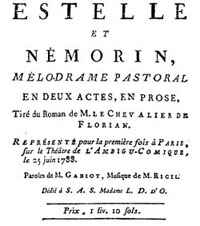
![]()

 |
|
 |
This page is also available in French
![]()
Meylan, a village a few miles outside Grenoble, holds a special place in Berlioz’s life. The Meylan that Berlioz knew lay on a steep hill on the slopes of Mt Saint Eynard, and is known nowadays as Haut Meylan (High Meylan), a small community distinct from the present day Meylan which lies lower down in the valley; the earliest buildings in modern Meylan date from the 1950s.
The composer’s maternal grandfather Nicolas Marmion lived in Meylan, and the young Hector and the rest of the family used to visit him every summer. But above all, the significance of Meylan for Berlioz was that it was there that in 1815, when aged only 12, he first met Estelle Dubœuf, who was six years his senior (she was born in 1797); he conceived a passion for her which was to last to the end of his life. Estelle and her sister Ninon would normally pass part of the summer with their maternal grandmother Madame Anne Gautier in Replat, above Meylan. Nancy Clappier, Madame Gautier’s niece, was a close friend of Berlioz’s mother and the two families would often meet socially in Meylan.
Estelle Dubœuf, later Estelle Fornier, was the younger daughter of a tax official from Grenoble. In the late 1820s Estelle married a man considerably older than herself, a rich lawyer called Casimir Fornier, who became president of the High Court in Grenoble. She had six children, of whom four survived into adulthood. Her husband died in 1845.
Estelle, whom Berlioz refers to as his ‘Stella montis’, appears several times in Berlioz’s Memoirs. She is mentioned in detail in 3 chapters of the work (chapters 3, 58 and the concluding Voyage en Dauphiné), and otherwise receives a passing mention in a few other chapters (24, 46 and 59; see further below). The writing of the Memoirs stretched over many years: Berlioz started writing them in 1848 while in London, but the work was only concluded at the beginning of 1865. Their character evolved in time, but it was only late in the day, in 1864, that the Memoirs received their final shape and Estelle became retrospectively the central figure in the work. She provided both the beginning and the end, and love for her was one of the two guiding threads of Berlioz’s entire career, the other one being music, as he writes near the end of the final chapter: ‘Which of these two powers can elevate man to the most sublime heights, love or music?... […] Why separate them? they are the two wings of the soul’ (see further the page on the composition and history of the Memoirs, and in particular the section on the concluding Voyage en Dauphiné).
It is not clear how many times Berlioz met Estelle, though visits came to an end already the following year (Memoirs, chapter 3); for him she was a remote and idealised figure, but he never forgot her, and the figure of Estelle continued to haunt his imagination throughout his life. He saw her by accident very briefly again in 1832 on his return from his trip to Italy, though she may not have recognised him on that occasion (chapter 3, end). He briefly mentions her in relation to his infatuation with the actress Harriet Smithson in 1827 (beginning of chapter 24). At the time of the writing of his Requiem in 1837 he mentions having twice had a dream concerning Estelle (footnote to chapter 46). In 1848, after the death of his father, Berlioz made a return visit to La Côte-Saint-André, but then insisted on revisiting Meylan, for the first time in 32 years. He wanted to see once again the place where he had first seen Estelle, and also to enquire about her; the visit is related in detail in the Memoirs (chapter 58). Berlioz even wrote a letter to her, the text of which he reproduces at the end of the chapter. The letter remained unanswered, but a footnote to the chapter shows that subsequently (in 1854) Berlioz continued to enquire about her. He found out that she was still alive and residing in Lyon, though a passing reference in the following chapter, which is dated 18 October 1854, implies that at the time of writing he did not expect to see her ever again. Yet in 1864, almost at the end of his active career, Berlioz was seized again with a longing to revisit Meylan. This time the story had a happy sequel: in September 1864 he managed to meet Estelle, for the first time in over 30 years (since 1832), at her home in Lyon. He was accepted as a family friend by her, her son and his family, who by 1865 had moved to Geneva, and started a correspondence with her. Estelle’s son Charles and daughter-in-law Suzanne visited Berlioz in Paris, and he visited them and Estelle twice in Geneva in 1865 and 1866, staying at the Hôtel de la Métropole; he later saw her in Saint Symphorien d’Ozon near Lyon where she eventually settled. All this is related in detail in the concluding section of the Memoirs (the Voyage en Dauphiné), and Berlioz chose to finish the account of his life on that note: ‘Stella! Stella! I can now die without bitterness or anger’ (the chapter is dated 1 January 1865). The wheel had now come full circle and Berlioz was able to conclude the account of his life on a positive note. In his will Berlioz left Estelle a life annuity of 1,600 francs which helped to make her last years more comfortable: ‘I beg her to accept this modest sum in memory of the feelings which I had for her during my whole life’. She died in 1876 and was buried in Saint Symphorien.
This section is intended to illustrate over several pages the setting of this remarkable love story: first the house of Berlioz’s grandfather Nicolas Marmion in Meylan and his tomb in the cemetery there; then the house of Madame Gautier, Estelle Dubœuf’s grandmother, with citation of relevant sections of Berlioz’s Memoirs; then views of the Saint-Eynard mountain which forms the backdrop to the village of Meylan; and finally the Berlioz Monument in the modern Meylan further down the valley, set up in 2003, the bicentenary of the composer’s birth, to commemorate Berlioz and his association with Estelle.
Related pages:
The house of Nicolas Marmion, Berlioz’s grandfather
The house of Madame Gautier, Estelle Fornier’s
grandmother
The Saint-Eynard
The Berlioz Monument
Copyright notice: The texts, photos, images and musical scores on all pages of this site are covered by UK Law and International Law. All rights of publication or reproduction of this material in any form, including Web page use, are reserved. Their use without our explicit permission is illegal.
![]()
The Hector Berlioz Website was created by Monir Tayeb and Michel Austin on 18
July 1997;
The Berlioz in Meylan pages were created on 15 April 2004, and enlarged on 1
October 2009. Revised on 1 June 2023.
© Monir Tayeb and Michel Austin. All rights reserved.